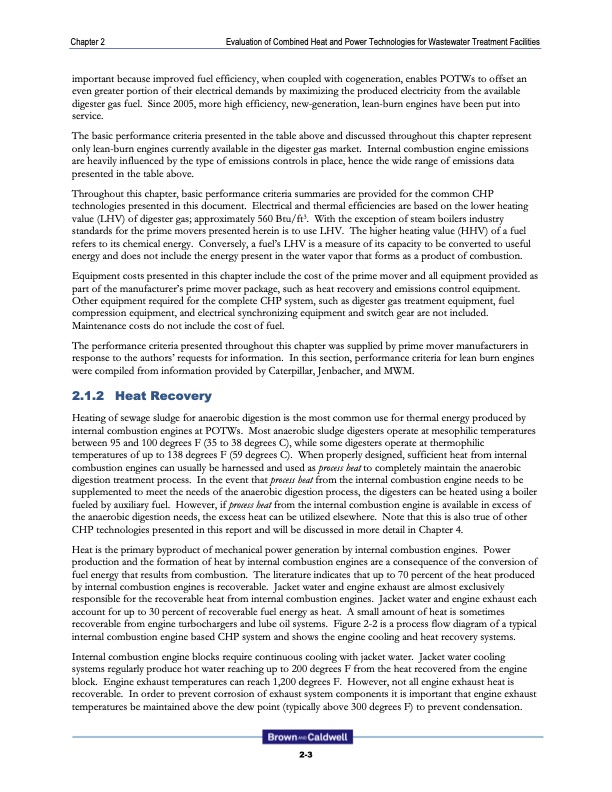
PDF Publication Title:
Text from PDF Page: 028
Chapter 2 Evaluation of Combined Heat and Power Technologies for Wastewater Treatment Facilities important because improved fuel efficiency, when coupled with cogeneration, enables POTWs to offset an even greater portion of their electrical demands by maximizing the produced electricity from the available digester gas fuel. Since 2005, more high efficiency, new-generation, lean-burn engines have been put into service. The basic performance criteria presented in the table above and discussed throughout this chapter represent only lean-burn engines currently available in the digester gas market. Internal combustion engine emissions are heavily influenced by the type of emissions controls in place, hence the wide range of emissions data presented in the table above. Throughout this chapter, basic performance criteria summaries are provided for the common CHP technologies presented in this document. Electrical and thermal efficiencies are based on the lower heating value (LHV) of digester gas; approximately 560 Btu/ft3. With the exception of steam boilers industry standards for the prime movers presented herein is to use LHV. The higher heating value (HHV) of a fuel refers to its chemical energy. Conversely, a fuel’s LHV is a measure of its capacity to be converted to useful energy and does not include the energy present in the water vapor that forms as a product of combustion. Equipment costs presented in this chapter include the cost of the prime mover and all equipment provided as part of the manufacturer’s prime mover package, such as heat recovery and emissions control equipment. Other equipment required for the complete CHP system, such as digester gas treatment equipment, fuel compression equipment, and electrical synchronizing equipment and switch gear are not included. Maintenance costs do not include the cost of fuel. The performance criteria presented throughout this chapter was supplied by prime mover manufacturers in response to the authors’ requests for information. In this section, performance criteria for lean burn engines were compiled from information provided by Caterpillar, Jenbacher, and MWM. 2.1.2 Heat Recovery Heating of sewage sludge for anaerobic digestion is the most common use for thermal energy produced by internal combustion engines at POTWs. Most anaerobic sludge digesters operate at mesophilic temperatures between 95 and 100 degrees F (35 to 38 degrees C), while some digesters operate at thermophilic temperatures of up to 138 degrees F (59 degrees C). When properly designed, sufficient heat from internal combustion engines can usually be harnessed and used as process heat to completely maintain the anaerobic digestion treatment process. In the event that process heat from the internal combustion engine needs to be supplemented to meet the needs of the anaerobic digestion process, the digesters can be heated using a boiler fueled by auxiliary fuel. However, if process heat from the internal combustion engine is available in excess of the anaerobic digestion needs, the excess heat can be utilized elsewhere. Note that this is also true of other CHP technologies presented in this report and will be discussed in more detail in Chapter 4. Heat is the primary byproduct of mechanical power generation by internal combustion engines. Power production and the formation of heat by internal combustion engines are a consequence of the conversion of fuel energy that results from combustion. The literature indicates that up to 70 percent of the heat produced by internal combustion engines is recoverable. Jacket water and engine exhaust are almost exclusively responsible for the recoverable heat from internal combustion engines. Jacket water and engine exhaust each account for up to 30 percent of recoverable fuel energy as heat. A small amount of heat is sometimes recoverable from engine turbochargers and lube oil systems. Figure 2-2 is a process flow diagram of a typical internal combustion engine based CHP system and shows the engine cooling and heat recovery systems. Internal combustion engine blocks require continuous cooling with jacket water. Jacket water cooling systems regularly produce hot water reaching up to 200 degrees F from the heat recovered from the engine block. Engine exhaust temperatures can reach 1,200 degrees F. However, not all engine exhaust heat is recoverable. In order to prevent corrosion of exhaust system components it is important that engine exhaust temperatures be maintained above the dew point (typically above 300 degrees F) to prevent condensation. 2-3PDF Image | Combined Heat and Power Technologies for Wastewater Facilities

PDF Search Title:
Combined Heat and Power Technologies for Wastewater FacilitiesOriginal File Name Searched:
300_CHP-EPA-w-Apps.pdfDIY PDF Search: Google It | Yahoo | Bing
Capstone Turbine and Microturbine: Capstone microturbines used and new surplus for sale listing More Info
Consulting and Strategy Services: Need help with Capstone Turbine, sizing systems, applications, or renewable energy strategy, we are here to assist More Info
Container Lumber Dry Kiln: Since 1991 developing and innovating dry kilns using standard shipping containers More Info
Supercritical CO2 Lumber Dry Kiln: Compact fast drying in 3 days or less for small amounts of wood and lumber drying More Info
BitCoin Mining: Bitcoin Mining and Cryptocurrency... More Info
Publications: Capstone Turbine publications for microturbine and distributed energy More Info
FileMaker Software for Renewable Energy Developing database software for the renewable energy industry More Info
CO2 Gas to Liquids On-Demand Production Cart Developing a supercritical CO2 to alcohol on-demand production system (via Nafion reverse fuel cell) More Info
Stranded Gas for low cost power Bitcoin Mining Using stranded gas for generators may provide breakthrough low power costs for cryptocurrency miners. More Info
| CONTACT TEL: 608-238-6001 Email: greg@globalmicroturbine.com | RSS | AMP |